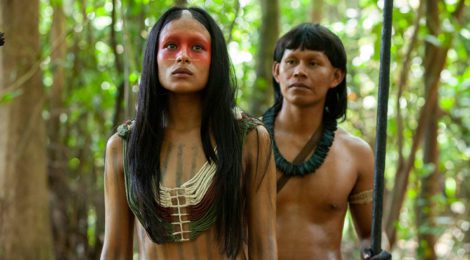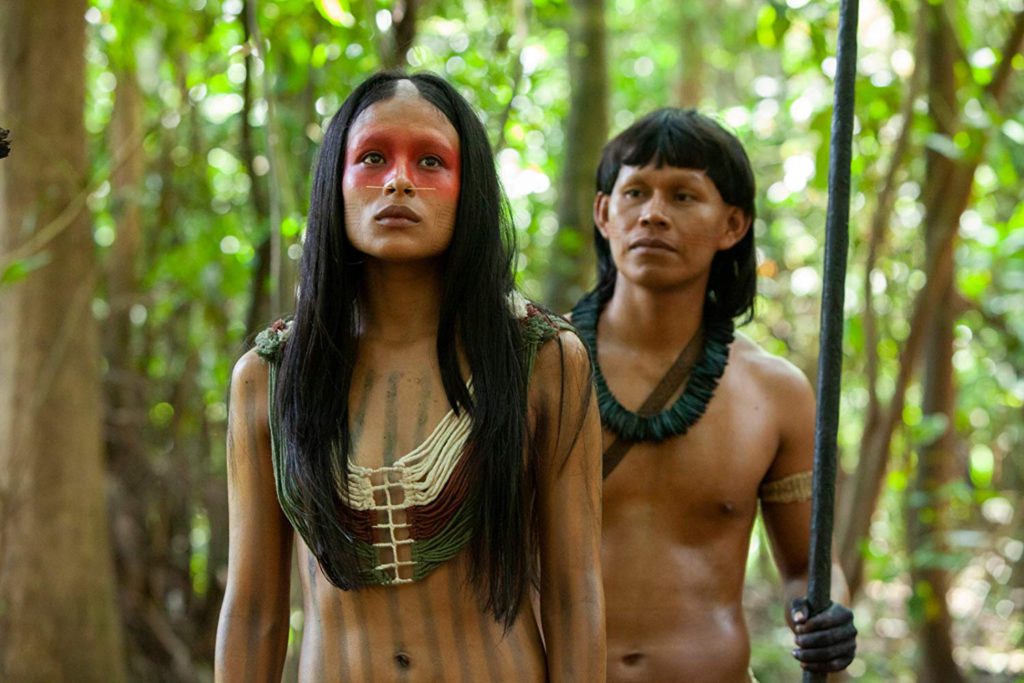
Frontera verde/Green Frontier (2019): Amazonia from Social Media to Netflix
Today at Mediático we are delighted to present an analysis of the new Netflix series Frontera Verde/Green Frontier by Julia R. Brown, that explores how the TV show sustains and expands the public conversation initiated by the #prayforAmazonia campaign, raising related concerns of social and environmental justice. Julia is a Ph.D. Candidate in Hispanic Literatures at the University of California, Santa Barbara. She has taught Spanish language, literature and cinema courses and has also served as an editorial assistant and managing editor for Mexican Studies/EstudiosMexicanos. Contact her at juliabrown@umail.ucsb.edu
Frontera Verde/Green Border (2019): Amazonia from Social Media to Netflix
by Julia Brown
(Frontera Verde, 2019, Trailer)
#PrayforAmazonia
On August 19th, 2019, a mere three days after Netflix released the eight-part fictional miniseries, Frontera Verde, the #PrayforAmazonia campaign exploded across social media.[1] Photos of flames engulfing trees flooded the internet, and a few startling satellite images captured immense smoke clouds visible from outer space. Critics responded that “Earth’s Lungs are burning,” a buzzy slogan, minimized the importance of other forests, also noting that some of the circulating images were years old.[2] Yet the critiques, like the #PrayforAmazonia campaign, were ephemeral: the trend quickly receded from the public eye.[3]
Although it’s unlikely that Frontera Verde’s producers knew of the imminent #PrayforAmazonia campaign,[4] the movement indisputably gave credence to the show’s central themes. In turn, the TV show sustains and expands the public conversation initiated by the campaign, raising related concerns of social and environmental justice. Frontera verde also reframes the campaign by reminding viewers that deciding to suddenly care is a privilege: for the show’s protagonists, the Amazon’s wellbeing is a matter of life and death.
A Green Border
In Borderlands/La Frontera Gloria Anzaldúa writes that the border is “a vague and undetermined place created by the emotional residue of an unnatural boundary. It is in a constant state of transition. The prohibited and forbidden are its natural inhabitants” (25). The “Green Border,” like the U.S.-Mexico border, is multidimensional and transgressive: it’s a place where tribal elders cross paths with loggers and vendors selling Chinese-made kitchenware; where Europeans thirsting for adventure or power share bus rides with Brazilians and Colombians shuttling between the fictional border towns of Puerto Manigua and Yurumí (according to one critic based on Leticia, Colombia and Tabatinga, Brazil).[5] Two manmade borders intersect here: the national and the environmental, where pavement ends and the Amazon begins. The rainforest is more than a backdrop, though; it’s a character referred to as “La Manigua,” or dense, impenetrable, or untouched forest in Taíno.[6] For the Colombian nuns in Puerto Manigua, it’s Eden: its indigenous inhabitants, the sinless children of God.
Intersecting Lives
Just as Anzaldúa traces U.S.-Mexico border history, Frontera Verde tells a story set on the border during the 1940s, 1980s and 2010s. This is a murder mystery series, and the show begins at the scene of a multiple femicide, which Agent Helena Poveda (Juana del Río) is sent from Bogotá to investigate.

The intersecting borders are mirrored in the show’s plot in the intersecting relations between characters. Agent Poveda’s personal history is linked to that of Yua (Miguel Dionisio Ramos), leader of the Arupani people and Ushë (Ángela Cano), his Mananuc partner and protegée. Yua trains Ushë as a new “eternal:” a being connected to the metaphysical heart of the Amazon. The two communicate telepathically and are perpetually youthful; a quality reminiscent of that used by early European chronicles to describe Taínos living in a perceived Antillean paradise. Unlike the romanticized Taínos of the 16th century, however, the “Caminantes” (“Walkers”) forsee tragedy for their people and the Amazon, and they respond forcefully. This is an uphill battle: colonialism’s oppressive forces abound. Joseph Schultz (Bruno Clairefond), a power-hungry Nazi scientist, targets Yua and Ushë, and Ushë becomes the center of a cult of nuns who see her as validation for their religious beliefs. Echoing Yua and Ushë’s struggles, local policeman Reynaldo (Nelson Camayo), assigned as Agent Poveda’s partner, grapples with his identity as a Nai man in non-indigenous Colombian society and as an exile from his village.

Myth and Misrepresentation
Frontera verde spins a web of relations linking indigenous and non-indigenous characters and does them diligence with thoughtful character development. Still, the likely majority of viewers is non-indigenous and unfamiliar with the communities on the Colombian-Brazilian border. This makes the show’s reception potentially problematic for a few reasons.
First, inventing indigenous communities is risky: the Nai, Arupani and Mananuc are fictional, seemingly based on villages from the southern Colombia-Brazil border. Yet according to a recent Colombian government census, Witoto-speaking communities are mostly concentrated near Colombia’s southern border with Peru. [7] This could be interpreted as a misrepresentation of the demographic layout of indigenous groups in Southern Colombia and is perhaps a lost opportunity to inform international spectators about Witoto-speaking communities.
Second, the show fictionalizes Arupani mythologies, creating a pastiche of tropes instead of transmitting the actual, rich oral histories of Witoto-speaking communities. As such, the series does not corroborate or give appropriate weight to indigenous epistemologies but instead projects Occidental imaginaries onto indigenous belief systems. Still, the show breaks ground by privileging Witoto as highly as Spanish and Portuguese, and by drawing attention to the Amazon Rainforest as a dynamic political touchstone which is home to immense cultural and ecological diversity.
Conclusion
At this point, it is impossible not to circle back to the Amazon’s current state of affairs: as fires burn at unusually high rates on the Brazilian side of the Amazon, critics point to the Bolsonaro Administration’s inattention to slash and burn farming as one cause.[8] Some indigenous activists have communicated that Bolsonaro is attempting to carry out a genocide of their peoples, making the Nazi scientist’s agenda in Frontera verde feel particularly timely.[9]
Yet as Frontera Verde demonstrates, threats to Amazon societies and ecosystems precede the Bolsonaro Administration and the 2019 fires which are burning in record numbers across the forest.[10] Given the uncertain terms on which the miniseries concludes, there is speculation about a second season: perhaps season two will point a way out of the commodification, romanticization, and destruction of “La Manigua” and its inhabitants.
References:
Gloria Anzaldúa (2012) Borderlands/La Frontera: The New Mestiza. (4th ed., 25th
anniversary ed.). San Francisco: Aunt
Lute Books.
[1] https://www.commondreams.org/news/2019/08/20/prayforamazonia-goes-viral-twitter-users-call-attention-international-emergency.
[2]See https://www.npr.org/2019/09/02/756679285/what-earths-forest-fires-mean-for-its-oxygen-levels and https://factcheck.afp.com/prayforamazonas-thousands-people-are-sharing-old-pictures-posts-about-amazon-rainforest-fires
[3] https://twitter.com/BellaLack/status/1169353145962717184
[4] Mauricio Leiva-Cock, Jenny Ceballos and Diego Ramírez-Schempp, collaborating with Colombian director Ciro Guerra (director of acclaimed films with Wayuu and Ocaina speaking protagonists; Pájaros de Verano [2018] and El abrazo de la serpiente [2015])
[5] https://sabanerox.com/2019/08/19/frontera-verde-analisis-y-explicacion/
[6] Rafael García Bido, Voces del Bohío, Archivo General de la Nación, Colección Cuadernos Populares, “maleza, bosque tupido,” p100.
[7] https://www.mininterior.gov.co/sites/default/files/upload/SIIC/PueblosIndigenas/pueblo_uitoto.pdf
[8] https://www.nytimes.com/2019/08/23/world/americas/amazon-fire-brazil-bolsonaro.htmlhttps://www.nytimes.com/2019/08/23/world/americas/amazon-fire-brazil-bolsonaro.html
[9] https://www.lasexta.com/noticias/internacional/miles-personas-indigenas-protestan-brasil-politicas-bolsonaro-quieren-matar-nuestra-gente_201904275cc423700cf22d02fea57fbc.html







Seems to have started out with good intentions…but then got mired in all kinds of unnecessary subplots. Good attempts at weaving the visions in but in the end seemed more like an outsider’s hallucinogenic dream about “indigenous wisdom.” The lure of ayahuasca continues…